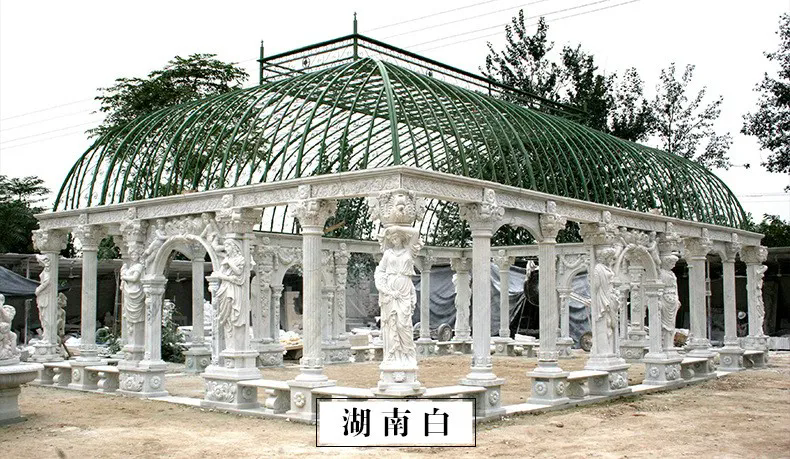Stone Pavilion Sculptures: Timeless Elegance in Art and Architecture
2024-09-04
In the world of art and architecture, stone pavilion sculptures stand out as enduring symbols of elegance, craftsmanship, and cultural heritage. These remarkable creations blend artistic expression with architectural prowess, offering both aesthetic beauty and functional utility. In this blog, we delve into the world of stone pavilion sculptures, exploring their history, design, significance, and the enduring appeal that makes them a cherished element in various settings.
What Are Stone Pavilion Sculptures?
Stone pavilion sculptures are artistic and architectural structures crafted from stone, designed to serve both decorative and functional purposes. Typically, they consist of a central pavilion or alcove surrounded by intricately carved stonework. These pavilions can vary in size, style, and complexity, from small garden ornaments to grand public monuments. The use of stone as the primary material lends these structures a timeless quality and a sense of permanence.
Key Features of Stone Pavilion Sculptures
1. Artistic Carvings and Details
Stone pavilion sculptures are renowned for their elaborate carvings and intricate details. Skilled artisans use various techniques to create patterns, motifs, and figures that enhance the visual appeal of the pavilion. Common themes include floral designs, mythical creatures, and historical scenes.
2. Architectural Design
The design of stone pavilions often incorporates elements of traditional architecture, such as columns, arches, and domes. These architectural features not only add to the aesthetic value but also contribute to the structural integrity of the pavilion.
3. Durability and Longevity
Stone is a highly durable material that can withstand the test of time and the elements. Stone pavilions are built to last, maintaining their beauty and structural stability for generations. This durability makes them ideal for both indoor and outdoor settings.
4. Cultural and Symbolic Significance
Stone pavilion sculptures often carry cultural and symbolic meanings. They can represent historical events, religious beliefs, or artistic movements. The incorporation of these elements adds depth and context to the pavilion, enriching its significance.
5. Functional Aspects
In addition to their decorative purposes, stone pavilions can serve functional roles. They may provide shelter, serve as gathering spaces, or act as focal points in gardens and public areas. Their versatility allows them to be integrated into various settings and uses.
Benefits of Stone Pavilion Sculptures
1. Timeless Appeal
The use of stone in pavilion sculptures ensures a classic and timeless aesthetic. Stone's natural beauty and texture provide an elegant and sophisticated look that transcends trends and remains relevant across different eras.
2. Durability
Stone's durability makes it an excellent choice for sculptures intended to last for many years. Stone pavilions can withstand environmental conditions such as weathering, erosion, and UV exposure, making them suitable for outdoor installations.
3. Cultural Heritage
Stone pavilion sculptures often reflect the cultural heritage and artistic traditions of a region. They serve as important cultural artifacts that preserve and celebrate historical and artistic achievements.
4. Architectural Integration
The architectural elements of stone pavilions allow them to integrate seamlessly into various architectural styles and settings. Whether in a traditional garden, a modern urban landscape, or a historical site, stone pavilions can enhance the surrounding environment.
5. Aesthetic Enhancement
The intricate carvings and elegant design of stone pavilions contribute to the overall beauty and visual appeal of a space. They can serve as focal points, enhancing the aesthetic value of gardens, parks, and public areas.
Applications of Stone Pavilion Sculptures
1. Gardens and Landscapes
Stone pavilions are a popular choice for gardens and outdoor landscapes. They provide a stunning focal point, offer shaded areas for relaxation, and enhance the overall design of the garden.
2. Public Monuments
In public spaces, stone pavilion sculptures can serve as monuments or memorials. Their grandeur and durability make them suitable for commemorating historical figures, events, or cultural achievements.
3. Religious and Spiritual Sites
Stone pavilions are often used in religious and spiritual sites, such as temples, shrines, and meditation gardens. They create serene and sacred spaces for reflection and worship.
4. Private Estates
For private estates and luxury homes, stone pavilions add a touch of sophistication and elegance. They can be integrated into private gardens, courtyards, or recreational areas to create a distinctive and luxurious atmosphere.
5. Cultural and Historical Sites
Stone pavilions play a significant role in cultural and historical sites, where they serve as representations of artistic and architectural heritage. They contribute to the preservation and celebration of historical traditions.
Conclusion
Stone pavilion sculptures represent a harmonious blend of art, architecture, and craftsmanship. Their timeless elegance, durability, and cultural significance make them a cherished element in various settings, from private gardens to public monuments. Whether serving as decorative focal points, functional structures, or symbols of cultural heritage, these sculptures continue to captivate and inspire. Embrace the beauty and artistry of stone pavilion sculptures and discover how they can enhance and enrich your surroundings with their enduring charm and grace.



